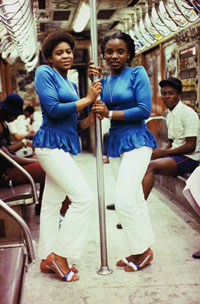HOW YA LIKE ME NOW?
NY HIPHOP STYLE OF THE 80'S:
Jamel Shabazz's famed photo collection
By Jude Kelly
 Like a lot of art forms, early hip-hop is under documented and most fans of modern rap know very little about the origins of this now global art form. Like a lot of art forms, early hip-hop is under documented and most fans of modern rap know very little about the origins of this now global art form.
The real experts were the folks who were there -- in the Bronx and other New York City boroughs -- experiencing first hand the birth and explosion of hip-hop culture.
Thankfully, Jamel Shabazz was on the scene then, photographing ordinary New Yorkers as they stylistically flaunted the clothes, fashion and attitude of this new underground movement. Visually archiving the early days of old skool hip hop fashion, Shabazz created an important body of work, entitled Back in the Days, which documents hip-hop street style from 1980-89. Wedge Gallery and ADIDAS Canada recently presented this exhibition in Toronto; it was the first time the work has been shown in Canada.
The collection is from Shabazz‚ first book, published by Powerhouse Books, one that chronicles a decade when b-boys and girls were content to front their Kangol caps, gold rope chains, Adidas sneakers -- and Mac Daddy posturing -- without expecting the bling-bling or fame of today‚s 15-minute wannabe celebrities. Just hangin', stylin', and chillin' all over the city and into the homes of youth around the world.
The Canadian premier of Back in the Days at SOF Art House took place on May 4 with more than 700 attendees, including the artist, who signed books, posters and even some skin, according to curator Dr. Ken Montague. The show -- 28 photos from the era -- was part of CONTACT 03 -- Toronto's annual photography festival, and ran during May at SOF. Shabazz also gave a sold-out lecture May 5 at the Art Gallery of Ontario.
Shabazz features portraits of ordinary New Yorkers on the streets of Brooklyn, Bronx and Harlem, and his photos form part of the unofficial history of that era, combining the formality of the studio with the spontaneity and grittiness of the street.
"Gates, walls, subways -- those were my galleries, my backdrops," Shabazz said in a recent interview for Columbia News Service.

Born in Brooklyn in 1960, Shabazz began taking pictures in high school. He grew up surrounded by cameras. His father spent eight years as a U.S. navy photographer and returned with images of the Mediterranean that entranced the young Shabazz, who started photographing his friends and schoolmates. The younger Shabazz spent three years in the army and when he got out in 1980 launched his passion fulltime.
"I was fortunate to photograph many men, women and children in their best years before crack and AIDS destroyed their communities," he wrote in his book. "The camera enabled me to tell a person how special and valuable they were and I had hoped that I could encourage people to look toward their own futures and believe in themselves."
Dr. Montague was immediately struck by Shabazz's work, which he discovered last summer in a bookstore at the Documenta Art Fair in Kassel, Germany. He recognized that the images from this photographer would complement the programming at Wedge Gallery, where he has previously featured the works and words of famed black photographers like Seydou Keita, 'Okhai Ojeikere and James VanDerZee.
"(Back in the Days) struck me as a complete record of that era," Dr. Montague says. "The book is very positive -- the poses very natural. To me the book's about empowerment, community spirit, unity and black power."
The 1980's were a fascinating period in the U.S. -- especially in New York. The city had just crawled out of the shadows of bankruptcy (thanks in large part to its catchy I Love NY tourism campaign) but was mean, dirty and violent. Street crime and the introduction of crack cocaine plagued the city, while federal cutbacks to social programs made things that much tougher for many black families, who also faced a double whammy of discrimination and unemployment. But out of this madness rose an art form that some critics initially dismissed as a fad, but that would eventually grow to become one of America's greatest cultural contributions to the world -- hip hop.
Born in the Bronx, but quickly embraced by rappers throughout the Big Apple, early hip-hop was largely the domain of inner city Blacks and Hispanics. But in 1979, Rapper's Delight by the Sugarhill Gang sold 10 million copies worldwide, and rap music was suddenly thrust into public consciousness.
Famed New York rapper, Fab 5 Freddy wrote the introduction to Back in the Days and explains: "These are the faces of the generation that gave birth to hip-hop -- not only the most dominate and inclusive youth culture in history, but also the most stylistically innovative and consistently advanced generation since the rock 'n roll era."
"Back then, cool was all about having the right flavor and savoir faire. Such a style blended a certain brand of rebelliousness with a casual nonchalance. It was a cocky confidence of sorts that was meticulously updated by a perpetual pursuit of an alternative, yet distinctive sensibility."
The hip attire and smug demeanor of pioneering New York rappers like Whodini, LL Cool J, Afrika Bambaataa, Roxanne Shante, Run-DMC and others fuelled this new street movement on the fashion front. In fact, Run, were the first non-athletes to endorse ADIDAS products, and the success of this bold move into retail helped whet corporate America's appetite to the power of hip hop marketing. Spike Lee's fictional b-boy, Mars Blackman, who later pitched for rival Nike, would have been proud: 'Do-ya-know? Do-ya-know? Do-ya-know? It's gotta be the shoes!'
"The images in the book are timeless," Dr. Montague says, "The fashion and style of the times has come back full circle; remember, that the origins of hip-hop began in a much more positive spirit than the current state of hip-hop where rappers pose with the biggest scowl and toughest pose."
 Education and mentoring were an important part of Shabazz' trip to Toronto, which included Subway Experience, where a group of teenagers rode the TTC and walked the city streets, producing a documentary-style photo perspective on the city. Light Source Photographic Collective, a non-profit group that encourages young photographers in Toronto, sponsored the workshop. Education and mentoring were an important part of Shabazz' trip to Toronto, which included Subway Experience, where a group of teenagers rode the TTC and walked the city streets, producing a documentary-style photo perspective on the city. Light Source Photographic Collective, a non-profit group that encourages young photographers in Toronto, sponsored the workshop.
In conclusion, to paraphrase a recent Vibe magazine quote: 'Back in the Days is a landmark book, an important examination of urban and youth culture, examined through the lenses of Shabazz. As photographer-forerunner Seydou Keita did for Africa in the 40's and '50's, Shabazz has captured urban culture, especially hip-hop's infancy, at its most stylish. His subjects strut as upon a stage, light years from the self-important, and more materialistic, present.'
<Back to top>
|







 Like a lot of art forms, early hip-hop is under documented and most fans of modern rap know very little about the origins of this now global art form.
Like a lot of art forms, early hip-hop is under documented and most fans of modern rap know very little about the origins of this now global art form.
 Education and mentoring were an important part of Shabazz' trip to Toronto, which included Subway Experience, where a group of teenagers rode the TTC and walked the city streets, producing a documentary-style photo perspective on the city. Light Source Photographic Collective, a non-profit group that encourages young photographers in Toronto, sponsored the workshop.
Education and mentoring were an important part of Shabazz' trip to Toronto, which included Subway Experience, where a group of teenagers rode the TTC and walked the city streets, producing a documentary-style photo perspective on the city. Light Source Photographic Collective, a non-profit group that encourages young photographers in Toronto, sponsored the workshop.